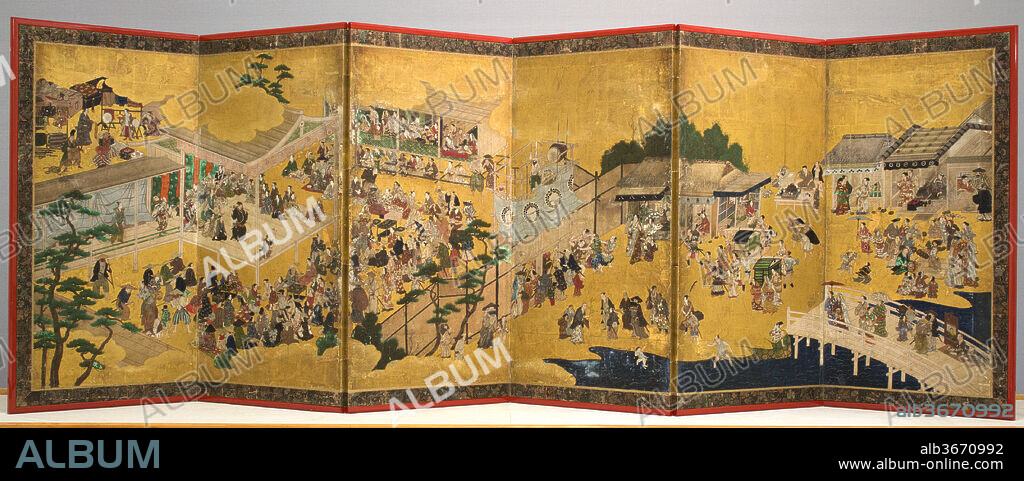alb3670992
STUDIO OF KANO TAKANOBU. Women's Kabuki (Onna kabuki zu byobu)

|
Añadir a otro lightbox |
|
Añadir a otro lightbox |



¿Ya tienes cuenta? Iniciar sesión
¿No tienes cuenta? Regístrate
Compra esta imagen

Título:
Women's Kabuki (Onna kabuki zu byobu)
Descripción:
Ver traducción automática
Women's Kabuki (Onna kabuki zu byobu). Artist: Studio of Kano Takanobu (Japanese, 1571-1618). Culture: Japan. Dimensions: Image: 31 1/2 in. × 8 ft. 9 11/16 in. (80 × 268.4 cm)
Overall: 36 in. × 9 ft. 2 5/16 in. (91.5 × 280.2 cm). Date: probably mid- to- late 1610s.
The origins of Kabuki theatre are captured in this gloriously complex and meticulously detailed genre screen from the second decade of the seventeenth century. In its earliest phase, Kabuki was performed by female dancers or courtesans, playing both male and female roles in sexually provocative skits. Kabuki as we know it today, a highly respectable "classical" theatre performed entirely by male actors (for roles of both genders) in plays with complex plots, did not begin to emerge until the end of the seventeenth century.
The focus of this exuberantly detailed genre screen is the stage performance of a young woman dressed as a man, performing a skit called Chaya asobi, or "Teahouse Entertainments." She is dressed as a gallant samurai in flashy robes, posturing suggestively as she hoists a sword with gilded sheath behind her neck. She is accompanied at the front of the stage by her comic sidekick, the manservant Saruwaka ("Young Monkey")--also played by a woman--holding a branch of maple leaves or flowers. They engage in saucy dialogue with a female teahouse owner or courtesan in the right corner of the stage--a role sometimes played by a young man, according to records of performances of the day. Audiences apparently delighted in the erotic suggestiveness of cross-dressing.
This recently rediscovered work is believed to be the left screen of a pair; this scene of Kabuki was juxtaposed with depictions of merrymaking in the Kitano district of Kyoto. Both screens are thought to have been created in the Kano studio, probably under the direction of Takanobu, head of the atelier in the early seventeenth century.
Técnica/material:
Six-panel folding screen; ink, color, gold, silver, and gold leaf on paper
Periodo:
Edo period (1615-1868)
Museo:
Metropolitan Museum of Art, New York, USA
Crédito:
Album / Metropolitan Museum of Art, NY
Autorizaciones:
Modelo: No - Propiedad: No
¿Preguntas relacionadas con los derechos?
¿Preguntas relacionadas con los derechos?
Tamaño imagen:
4800 x 2008 px | 27.6 MB
Tamaño impresión:
40.6 x 17.0 cm | 16.0 x 6.7 in (300 dpi)
Palabras clave:
ARTE ASIATICO • ASIA • JAPON • METAL • METROPOLITAN MUSEUM OF ART, NEW YORK, USA • MUEBLES • ORO BATIDO • ORO • PAN DE ORO • PANELES • PANTALLAS • PAPEL • STUDIO OF KANO TAKANOBU • TINTA
 Pinterest
Pinterest Twitter
Twitter Facebook
Facebook Copiar enlace
Copiar enlace Email
Email
